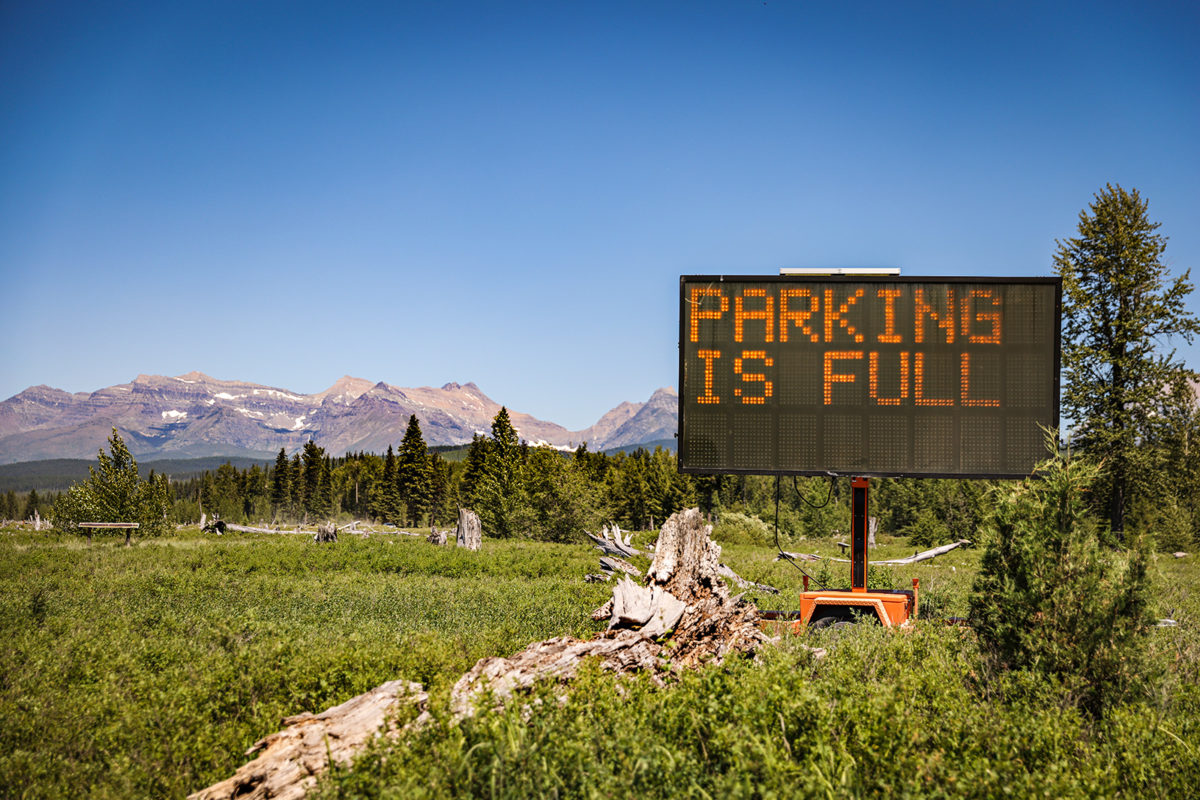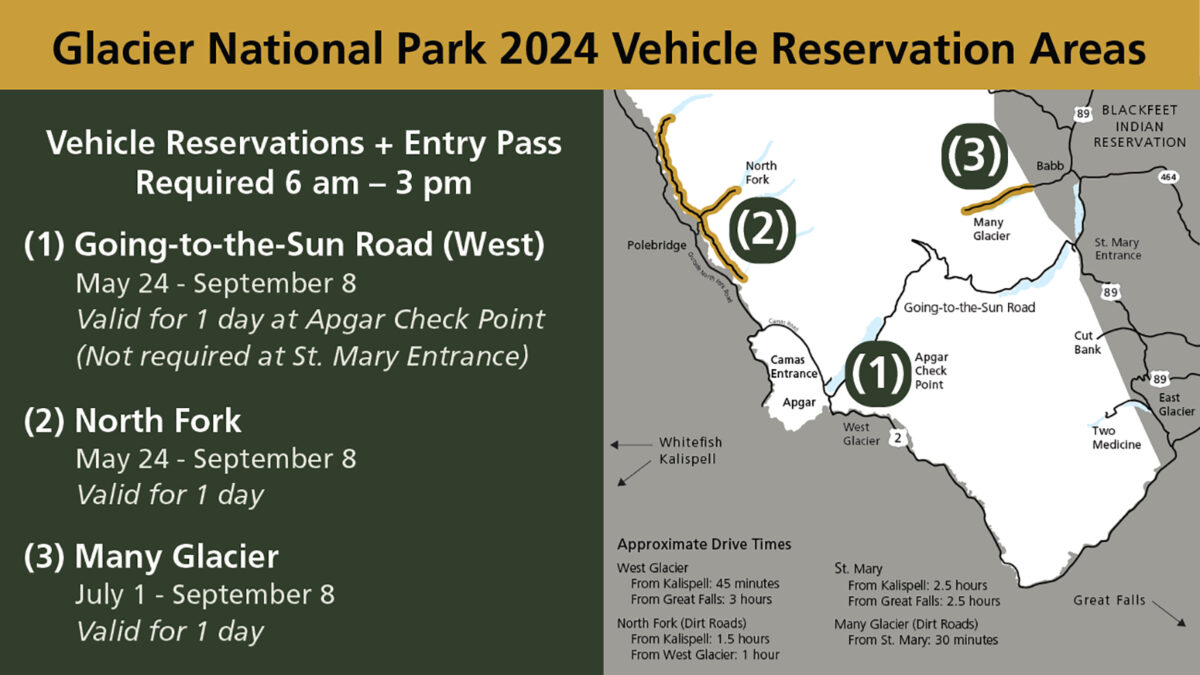Glacier National Park Announces Changes to Vehicle Reservation System for 2024
Park officials said the managed access system will only include three popular entrances next year, exempting Two Medicine and St. Mary from the requirement
By Micah Drew
Visitors to Glacier National Park in 2024 will again be required to have a vehicle reservation to access the Park’s most popular areas, but the process will look a little different than in years past. Park officials announced on Thursday that the fourth year of a pilot vehicle reservation system will be implemented on a smaller scale than it was in 2023.
As opposed to this summer, when vehicle reservations were required to access all six main entrances to the park, visitors will only need advanced reservations to access the North Fork area at Polebridge, the Many Glacier valley and the West Glacier entrance to the Going-to-the-Sun Road.
“Our balanced approach for the 2024 pilot reflects feedback from Tribes, the public, partners, and stakeholders, particularly regarding access to the Apgar Village area and Two Medicine,” Glacier National Park Superintendent Dave Roemer said in a press release. “We also heard that knowing what park operations and access will look like sooner, rather than later, is important.”
The biggest change to the vehicle reservation system is centered on Going-to-the-Sun Road, the iconic alpine highway that bisects that heart of the park. Beginning May 24, reservations will be required to travel the road from the west side beyond the Apgar Village area from 6 a.m. to 3 p.m.
Three new changes will take effect next year: reservations will be valid for one day only, as opposed to three; a reservation checkpoint will be set up past Apgar Village, allowing visitors to access the Apgar area, including the visitor center, lodging, camping and transportation, without a reservation; and reservations are only required to access Going-to-the-Sun Road from the west. Visitors entering the park from St. Mary will not need an advance reservation.
Park officials cited data from 2023 indicating that only 2% of three-day reservations were utilized all three days, and said that by shifting to a single-day system more reservations can be provided to visitors. In addition, since Apgar Village will be accessible without a reservation, any lodging, camping, transportation or commercial activity reservations originating in Apgar will no longer provide access beyond the Apgar check point.
Access to the North Fork area at Polebridge and the Many Glacier Valley will not change from 2023. Each vehicle will require a one-day reservation between 6 a.m. and 3 p.m. beginning May 24 at Polebridge and July 1 at Many Glacier.
The park entrance at Two Medicine will not require a vehicle reservation in 2024.
“We will be testing vehicle reservations proactively in areas where congestion most frequently occurs – the North Fork, Many Glacier, and through the West Entrance to Going-to-the-Sun Road – and will take a wait-and-see approach at other locations and manage adaptively if needed,” Roemer stated. “In all locations, our goal is to learn how effective these systems are at improving visitor experiences and protecting park resources.”

The vehicle reservation system was first implemented in 2021 to relieve congestion from pandemic-era visitation records that saw many park entrances temporarily restrict access due to overcrowding. Each year, park officials have revised the pilot system based on feedback from local communities, visitor surveys and data, which this summer included hosting a trio of civic-assessment sessions in August and collecting 1,408 written comments.
The 2023 system was the most comprehensive version of the pilot program — with all entrances to the park included — but park data showed an overall increase in visitation compared to the previous summer despite the increased restrictions. “We think we might be dialing in the sweet spot right now,” Glacier Park Superintendent Dave Roemer told the Beacon in August.
Glacier is among myriad parks that have implemented a managed access system as National Park Service-managed units nationwide routinely count around 330 million total visitors. In addition to Glacier, officials at Arches National Park and Rocky Mountain National Park have already announced vehicle reservation systems for 2024.
“We applaud the National Park Service for taking bold and creative steps in recent years to protect natural and cultural resources and preserve high-quality visitor experiences,” said Cassidy Jones, senior visitation program manager for the National Parks Conservation Association. “Bringing managed access pilot systems back to Arches, Glacier, and Rocky Mountain in 2024 is a positive next step towards making these improvements permanent. We saw gridlock traffic and frustrated visitors return to Yosemite this year when its reservation system was suspended. We strongly support visitor use management at Arches and other parks to ensure poor visitor experience conditions don’t return there.”
As in previous years, the vehicle reservation system at Glacier will be managed through the recreation.gov website. While there is no cost for a reservation, a $2 processing fee is charged on each transaction. A portion of all reservations will be available on a rolling basis 120 days in advance, starting on Jan. 25, 2024 at 8 a.m. All remaining vehicle reservations will be available at 7 p.m. for next-day entry beginning on May 23, signaling another change from previous years, when reservations for next-day entry were released at 8 a.m.
Any visitor entering Glacier National Park is required to have a valid entrance pass —separate from a vehicle reservation — which include a seven-day $35 vehicle pass, an Interagency Annual/Lifetime Pass, or a Glacier National Park Annual Pass. Visitors can enter the park through all entrances before 6 a.m. or after 3 p.m. without a vehicle reservation, and tribal members and landowners inside the park are exempt from the reservation system.
